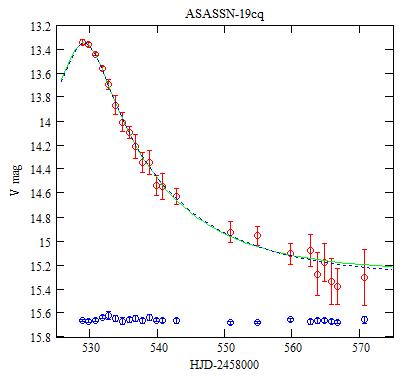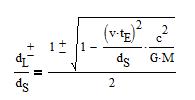ASASSN-19cq: a gravitational microlensing event
Observed: 23 sessions in Feb-Mar 2019
Michel Bonnardeau
28 Feb, 1, 8, 10, 12, 17, 20, 27 Mar, 5, 7, 11 Apr 2019
Abstract
Photometric observations of this microlensing event are presented and interpreted.
Introduction
The discovery of the candidate microlensing event ASASSN-19cq was reported by Sokolovsky et al (2019), on Feb 12. I observed this event from Feb 13 until Mar 27, 2019.
Observations
The observations were carried out with a 203mm f/6.3 Schmidt-Cassegrain telescope, a V filter and a ST7E camera (KAF-401E CCD). The duration of each exposure is 200 s. A total of 471 valid images were obtained over 23 sessions.
For the differential aperture photometry, the comparison star is UCAC4 383-92972 (RA=17:46:48.98 DEC=-13:30:30.1) with an APASS magnitude V=12.227, and the check star is UCAC4 383-93080 (RA=17:46:58.07 DEC=-13:30:43.9).
The light curves:

The individual measurements of ASASSN-19cq (red) and of the check star
shifted by +3.1 mag (blue).

Each dot is the average of one session, and the error bars are ±1
standard deviation.
Analysis
The theory
The theory of the gravitational microlensing is explained in Wikipedia.
According to the GAIA DR2 catalog, the parallax to the lensed object
is 0.0914±0.0389 mas so the distance is dS=10941±4656
pc. Let be dL the distance to the lensing object and M its
mass. The Einstein angle is then:

The angular distance u(t) from the lensing object to the lensed star
is, in unit of θE, with tE the Einstein time:

(umin, the impact parameter, is the minimum distance, at t=t0).
The amplification A of the flux from the lensed object is:

In the CMC14 catalog, the lensed star has the magnitudes r'=14.766, J=12.269, H=11.539 and K=11.325. Owing to the transformation formula of Bilir et al (2008) and Smith et al (2002) it can be computed that it has the magnitudes V0=15.389 and g0=16.217 in the V and g bands respectively (when not lensed).
The magnitude with the lensing effect is then:
V(t)=-2.5*log A(t)+V0
A Monte Carlo fit
The V(t) function is fitted to the observations using a Monte Carlo method. There are 4 parameters to be adjusted: umin, t0, tE and also V0. V0 needs to be adjusted because it is determined by transformations formulas, which are only approximate, and also to allow for a possible shift with the different photometry setups.
The 4 parameters are allowed to vary in the following ranges:
umin around 0.15 ± 0.1
t0 around the time of my first observation (2,458,528.71328
HJD) ± 1 day
tE around 26 ± 10 day
V0 around 15.389 ± 0.3 mag.
106 sets of 4 parameters are taken randomly and, for each set, the quadratic sum of the residuals of V(t) from the observations, weighted with the uncertainties on the magnitudes, is computed. The set that gives the smallest residual is selected.
The process is repeated 10 times. The averages and the standard deviations of the selected sets of parameters are retained as the best fit to the observations.
Actually, this is repeated a number of times to be sure that the results are stable and that there is no degeneracy (i.e. different sets of parameters fitting the observations).
The results are:
umin = 0.1715± 0.031
t0 = 2,458,529.023± 0.046 HJD
tE = 21.50± 0.58 days
V0 = 15.269± 0.018 mag
and the resulting fit is shown in the figure below:

Green: the V(t) function.
With blending: Another way to fit the observations is to take into account the
contribution of unresolved stars along the line of the sight to the overall
received light. This blending effect (Nucita et al, 2018) may be accounting
for by using the ratio of the source flux Fs to the total baseline flux
Fs+Fblend:
fs=Fs/(Fs+Fblend)
The magnitude with the lensing effect and the blending effect is then:
Vb(t)=-2.5*log[fs*(A(t)-1)+1]+2.5*log(fs)+V0
A Monte Carlo fit is again performed, with a 5th parameter fs,
to be searched between 1 and 0.5. The results are, with 10 runs of 107
trials:
umin = 0.1317± 0.0057
t0 = 2,458,529.088± 0.040 HJD
tE = 26.81± 0.95 days
V0 = 15.592± 0.053 mag
fs = 0.776± 0.034
and the resulting fit is shown in the figures below:

Dot blue: the Vb(t) function.

Red: residuals of the observations from the V(t) function, Blue: from the Vb(t) function.
About the microlens
The distance dL to the lensing object, as a function of its
mass M, for a given velocity v is:

with the + for the lens being closer to the lensed object, and - for it
closer to the observer.
The figure below gives dL as a function of M for a velocity
v=10km/s and for v=100km/s:

Continuous curves: dL+,
curves with dots: dL-. The 2 red curves on the left are
for v=10km/s, the 2 blue curves on the right are for
v=100km/s.
A Monte Carlo fit of the ASAS-SN data
The ASAS-SN data are available from https://asas-sn.osu.edu/.
There are 76 measurements from HJD 2458519.15453 to 2458578.77813, obtained
with a g filter. They are then fitted with the function:
g(t)=-2.5*log A(t)+g0
owing to the Monte Carlo method, as above, except for the magnitude without
the lens: g0 around 16.217 ± 0.6 (not 0.3 as above,
which appears to be too small here).
The results are:
umin = 0.2169 ± 0.022
t0 = 2,458,528.845 ± 0.022 HJD
tE = 18.04 ± 0.27 days
g0 = 15.711 ± 0.007 mag
With blending, the observations are fitted with the function,
the same way as with my observations:
gb(t)=-2.5*log[fs*(A(t)-1)+1]+2.5*log(fs)+g0
This gives:
umin = 0.151 ± 0.016
t0 = 2,458,528.843 ± 0.019 HJD
tE = 23.9 ± 1.9 days
g0 = 16.15 ± 0.12 mag
fs = 0.684 ± 0.070
The fit with the blending gives a value of g0 very close to the one obtained from the CMC14 catalog.
The parameters obtained with blending are the same as (within the uncertainties) those obtained from my observations, also with blending. The blending factor is a bit stronger for ASAS-SN.
The resulting fits are shown in the figures below:

Red: ASAS measurements, Green: the g(t) function, Dot blue: the
gb(t) function.

Red: the residuals from the g(t) function, Blue: from the gb(t) function.
Conclusions
Both my observations and the ASAS-SN observations are fitted with the same gravitational microlens lightcurve. Furthermore, these observations are in different wavelength bands, which comforts the microlens interpretation.
The lensing object may have a mass in the range of 1/100 solar mass (a brown dwarf), anywhere along the line of sight. There is no evidence for a binary.
References
Bilir S. et al (2008) MNRAS 384 1178.
Nucita A.A. et al (2018) MNRAS 476 2962.
Smith J.A. et al (2002) AJ 123 2121.
Sokolovsky K.V. et al (2019) ATEL #12495.
Technical notes
Telescope and camera configuration.
Computer and software configuration.
|
|
|||
|
|||
|
|
|||
|
|
|||
|
|||
